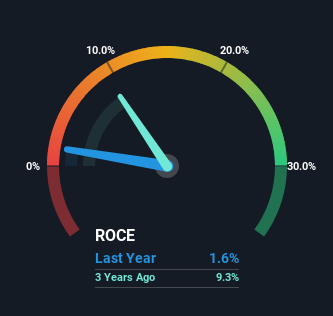- China
- /
- General Merchandise and Department Stores
- /
- SZSE:301001
Returns On Capital At Shanghai Kaytune IndustrialLtd (SZSE:301001) Paint A Concerning Picture
If you're looking for a multi-bagger, there's a few things to keep an eye out for. Firstly, we'd want to identify a growing return on capital employed (ROCE) and then alongside that, an ever-increasing base of capital employed. Basically this means that a company has profitable initiatives that it can continue to reinvest in, which is a trait of a compounding machine. In light of that, when we looked at Shanghai Kaytune IndustrialLtd (SZSE:301001) and its ROCE trend, we weren't exactly thrilled.
Understanding Return On Capital Employed (ROCE)
If you haven't worked with ROCE before, it measures the 'return' (pre-tax profit) a company generates from capital employed in its business. The formula for this calculation on Shanghai Kaytune IndustrialLtd is:
Return on Capital Employed = Earnings Before Interest and Tax (EBIT) ÷ (Total Assets - Current Liabilities)
0.016 = CN¥13m ÷ (CN¥909m - CN¥61m) (Based on the trailing twelve months to September 2024).
Therefore, Shanghai Kaytune IndustrialLtd has an ROCE of 1.6%. Ultimately, that's a low return and it under-performs the Multiline Retail industry average of 3.9%.
View our latest analysis for Shanghai Kaytune IndustrialLtd

While the past is not representative of the future, it can be helpful to know how a company has performed historically, which is why we have this chart above. If you want to delve into the historical earnings , check out these free graphs detailing revenue and cash flow performance of Shanghai Kaytune IndustrialLtd.
What Does the ROCE Trend For Shanghai Kaytune IndustrialLtd Tell Us?
In terms of Shanghai Kaytune IndustrialLtd's historical ROCE movements, the trend isn't fantastic. Over the last five years, returns on capital have decreased to 1.6% from 35% five years ago. Given the business is employing more capital while revenue has slipped, this is a bit concerning. This could mean that the business is losing its competitive advantage or market share, because while more money is being put into ventures, it's actually producing a lower return - "less bang for their buck" per se.
On a side note, Shanghai Kaytune IndustrialLtd has done well to pay down its current liabilities to 6.7% of total assets. That could partly explain why the ROCE has dropped. What's more, this can reduce some aspects of risk to the business because now the company's suppliers or short-term creditors are funding less of its operations. Some would claim this reduces the business' efficiency at generating ROCE since it is now funding more of the operations with its own money.
The Bottom Line
From the above analysis, we find it rather worrisome that returns on capital and sales for Shanghai Kaytune IndustrialLtd have fallen, meanwhile the business is employing more capital than it was five years ago. And long term shareholders have watched their investments stay flat over the last three years. That being the case, unless the underlying trends revert to a more positive trajectory, we'd consider looking elsewhere.
One more thing: We've identified 3 warning signs with Shanghai Kaytune IndustrialLtd (at least 2 which are significant) , and understanding these would certainly be useful.
For those who like to invest in solid companies, check out this free list of companies with solid balance sheets and high returns on equity.
New: Manage All Your Stock Portfolios in One Place
We've created the ultimate portfolio companion for stock investors, and it's free.
• Connect an unlimited number of Portfolios and see your total in one currency
• Be alerted to new Warning Signs or Risks via email or mobile
• Track the Fair Value of your stocks
Have feedback on this article? Concerned about the content? Get in touch with us directly. Alternatively, email editorial-team (at) simplywallst.com.
This article by Simply Wall St is general in nature. We provide commentary based on historical data and analyst forecasts only using an unbiased methodology and our articles are not intended to be financial advice. It does not constitute a recommendation to buy or sell any stock, and does not take account of your objectives, or your financial situation. We aim to bring you long-term focused analysis driven by fundamental data. Note that our analysis may not factor in the latest price-sensitive company announcements or qualitative material. Simply Wall St has no position in any stocks mentioned.
About SZSE:301001
Shanghai Kaytune IndustrialLtd
Provides e-commerce and customer relationship management services to enterprises.
Excellent balance sheet with slight risk.
Market Insights
Community Narratives



